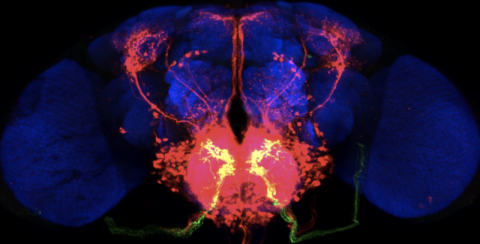Bringing bold ideas to life

Gilad Barnea, director of the Center for the Neurobiology of Cells and Circuits at the Robert J. and Nancy D. Carney Institute for Brain Science, has spent 20 years—a decade of those at Brown—developing the “trans-Tango” technology to map functional brain circuits that control behaviors.
“Many researchers view this as the Holy Grail in the field,” says Barnea.
But having a groundbreaking idea isn’t enough; early stage innovation needs its supporters to push the envelope of discovery. Nancy Zimmerman, who graduated in 1985 with a degree in economics, is one of them. Inspired by her mother’s work as an educator who understood that the brain has capacities beyond our limited understanding, she started the Zimmerman Fund for Scientific Innovation Awards in Brain Science in 2014 so that scientists could take risks and test bold ideas.
“We are learning about the brain, and we are experimenting with how to foster cutting-edge research that is both basic and applied science,” says Zimmerman.
Helping ideas get off the ground
Professor Diane Lipscombe, director of the Carney Institute, says that the importance of these Innovation Awards cannot be overstated. “They open up so many opportunities to catalyze great research into brain science, making Brown the best place in the world to discover, innovate, and develop new technologies,” says Lipscombe.
Barnea was an early recipient of an innovation award, which he emphasizes was critical for his project. “It enabled us to cross the finish line with our work in the lab, so we could publish our findings in Neuron, one of the premier scientific journals in neuroscience,” he says, adding that he has secured external funding to continue to develop the system.
Barnea’s published research—which was highly collaborative and involved undergraduate and graduate students as well as postdoctoral fellows—has generated considerable buzz from fellow scientists for the opportunities it opens to study specific circuits and how they become abnormal in disease. Barnea has since distributed the components of his system to more than 100 laboratories worldwide. Barnea’s group is developing versions of the technique to study cancer as well as the immune system.
Thanks to the support of the Innovation Awards, more promising studies are underway. Last year, six projects were granted approximately $700,000 total to advance insights into brain function and disease. This initiative continues to grow as more scientists across the brain science community see a path to test their most creative ideas.
One of those projects, led by Judy Liu, Sidney A. Fox and Dorothea Doctors Fox Professor of Ophthalmology and Visual Science, is searching for clues to better treat the genetic conditions behind autism and childhood epilepsy. Nearly a third of people affected by autism also have epilepsy, but the reason for this connection isn’t clearly understood—yet.
A launching pad for the next great solution
Opportunities at Brown to enact real change in the way we understand the brain are attracting the brightest minds in the fields, from early stage scientists—students—to more established scientists—faculty.
Across campus, more than 180 brain science faculty from 23 departments such as neurosurgery, engineering, and computer science are engaged in integrative research at any one time. Almost a quarter of all Brown undergraduates take Neuro 1: Introduction to Neuroscience, and many start their research careers in labs on College Hill or in clinical departments in Brown-affiliated hospitals.
“This collaborative approach is really the best chance we have as a society to reach scientific breakthroughs,” says Lipscombe. “Faculty and students from richly diverse backgrounds can come together to approach complex problems with fresh perspectives.”
The seeders of future discoveries? Alumni, such as Zimmerman, who recognize opportunities in brain science at Brown to advance knowledge, and to impact human lives.
“I cannot imagine being involved in anything more engaging, satisfying, and fun,” Zimmerman says.
Diane Lipscombe is the Reliance Dhirubhai Ambani Director of the Robert J. and Nancy D. Carney Institute for Brain Science, Thomas J. Watson Sr. Professor of Science, and professor of neuroscience at Brown University.
Gilad Barnea is director of the Center for the Neurobiology of Cells and Circuits at the Robert J. and Nancy D. Carney Institute for Brain Science, Sidney A. Fox and Dorothea Doctors Fox Professor of Ophthalmology and Visual Science, and associate professor of neuroscience at Brown University.



